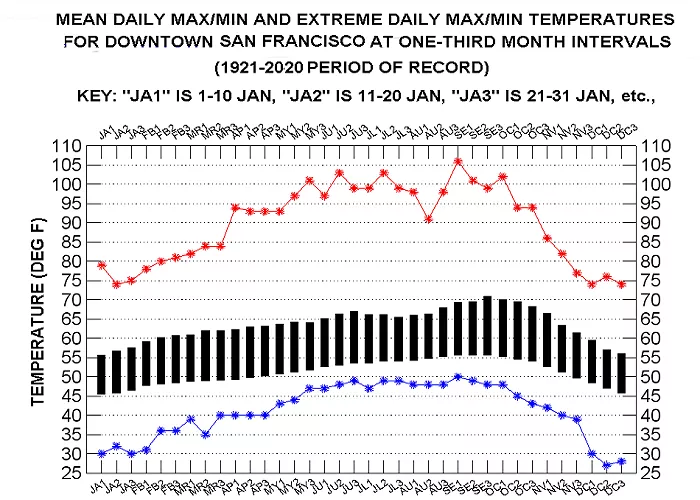San Francisco’s January weather offers a unique blend of mild temperatures, occasional rain, and the famous Bay Area fog. Unlike many other U.S. cities experiencing freezing winters, San Francisco maintains relatively temperate conditions, though with its own set of weather quirks. This comprehensive guide examines San Francisco’s January climate from multiple perspectives, helping visitors and residents alike prepare for the city’s distinctive winter weather patterns.
Temperature Ranges and Daily Averages
January is typically the coldest month in San Francisco, though “cold” is relative in this Mediterranean climate:
- Daytime Highs: Average 57°F (14°C), rarely exceeding 65°F (18°C)
- Nighttime Lows: Average 46°F (8°C), seldom dropping below 40°F (4°C)
- Record Extremes: The highest January temperature recorded was 79°F (26°C), while the lowest was 27°F (-3°C)
- Microclimates: The Mission District can be 10°F warmer than Sunset District on the same day
The coastal location moderates temperature swings, preventing both extreme cold and heat.
Rainfall and Precipitation Patterns
January falls within San Francisco’s rainy season, though precipitation amounts may surprise visitors:
- Monthly Average: 4.5 inches (114 mm) of rainfall
- Rainy Days: About 11 days with measurable precipitation
- Storm Systems: Typically Pacific storms lasting 2-3 days, followed by dry periods
- Flood Risks: Low-lying areas like the Mission Creek basin can experience minor flooding
While not excessively wet compared to other West Coast cities, the rain contributes to the city’s lush winter greenery.
Fog and Wind Conditions
San Francisco’s famous fog behaves differently in January than during summer months:
- Morning Fog: Less prevalent than summer, but still occurs about 40% of mornings
- Wind Patterns: Average wind speed of 8 mph, with stronger gusts near the coast
- Wind Chill: Can make temperatures feel 5-10°F colder than actual readings
- Coastal vs. Inland: The Embarcadero often windier than protected areas like Noe Valley
The combination of wind and moisture creates the damp chill characteristic of San Francisco winters.
Sunshine and Daylight Hours
January days are short but often include periods of sunshine:
- Daylight Duration: About 10 hours (sunrise ~7:20 am, sunset ~5:15 pm)
- Sunny Days: Approximately 15-18 days with at least partial sunshine
- UV Index: Typically 2-3 (low), but sunscreen still recommended
- Golden Hour: Beautiful late afternoon light on historic architecture
Despite being winter, sunny breaks between storms create excellent photography conditions.
Microclimates and Neighborhood Variations
San Francisco’s famous microclimates remain pronounced in January:
- Sunny Zones: Mission District and Potrero Hill often warmest and driest
- Foggy Areas: Sunset and Richmond Districts frequently cooler and foggier
- Wind Tunnels: Market Street and Twin Peaks experience stronger winds
- Bay Effect: Waterfront areas like Fisherman’s Wharf feel cooler and damper
Temperature variations of 10-15°F between neighborhoods are common, making layered clothing essential.
What to Wear in January
Proper attire is crucial for comfort in San Francisco’s January weather:
- Base Layer: Lightweight thermal or long-sleeve shirt
- Middle Layer: Warm sweater or fleece
- Outer Layer: Waterproof windbreaker or jacket
- Accessories: Scarf, gloves, and beanie for windy days
- Footwear: Comfortable, waterproof walking shoes
The key is dressing in removable layers to adapt to changing conditions throughout the day.
Best January Activities
San Francisco offers wonderful winter-appropriate activities:
- Museum Visits: Explore SFMOMA or the de Young Museum during rainy days
- Whale Watching: Peak season for gray whale migrations
- Urban Hikes: Clear winter days perfect for walking the Presidio or Lands End
- Cultural Events: SF Sketchfest comedy festival occurs in January
Fewer tourists and hotel deals make January an excellent time for urban exploration.
Conclusion
San Francisco’s January weather combines mild temperatures with periodic rain and the ever-present possibility of fog. While not as cold as many other American cities in winter, the damp chill and microclimate variations require thoughtful preparation. Visitors who pack proper layers and plan flexible itineraries will discover a quieter, more authentic side of the city. From storm-watching at Ocean Beach to cozying up in North Beach cafes, January offers unique opportunities to experience San Francisco without the crowds, making it an underrated time for a Bay Area visit.

